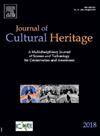利用液相色谱和高分辨率质谱法探索干燥油中脂肪酸的化学与酶解分析
IF 3.3
2区 综合性期刊
0 ARCHAEOLOGY
引用次数: 0
摘要
干燥油富含三酰甘油和不饱和脂肪酸酰基链,在艺术品中被广泛使用,因为它们在暴露于氧气时能够将它们转化为交联的聚合物网络,形成保护层。然而,随着时间的推移,酯键水解会释放脂肪酸(FAs),脂肪酸会聚集、迁移并与颜料相互作用,导致艺术品降解。了解干性油的脂质分布对保护文化遗产至关重要。采用反相液相色谱(RPLC) -电喷雾电离(ESI)、高分辨率质谱(HRMS)和串联质谱(MS/MS)技术,研究了红花(Carthamus tinctorius)、亚麻籽(Linum usitatissimum L.)、核桃(Juglans regia)和罂粟籽(Papaver somniferum)等常见干燥油中游离FAs和总FAs的组成。为了确定不饱和脂肪酸中CC双键的位置和几何形状(顺/反),我们与间氯过氧苯甲酸进行了温和的环氧化反应。在三种条件下分析油:没有事先水解,使用念珠菌脂肪酶酶解后(每mL提取样品0.25 mg酶,37℃孵育45分钟),或化学水解(0.5 M HCl, 100℃,1小时)。结果证明了水解方法之间的明显差异:与酶水解相比,化学水解在存在金属痕迹的情况下诱导异构化,产生额外的不饱和物种。这些转化通过FA环氧化物的MS/MS诊断离子及其保留时间来表征。为了保持天然FA的轮廓,尽量减少人工制品,建议酶水解或温和的化学条件,与C. rugosa脂肪酶提供可靠的参考标准。这种方法成功地应用于F. Rispoli在20世纪70年代创作的一幅布面油画,揭示了与衰老相关的脂质变化。本文章由计算机程序翻译,如有差异,请以英文原文为准。
Exploring chemical vs. enzymatic hydrolysis for fatty acid profiling of drying oils by liquid chromatography with high-resolution mass spectrometry
Drying oils, rich in triacylglycerols with unsaturated fatty acyl chains, are widely used in artworks for their ability to transform them into cross-linked polymer networks upon exposure to oxygen, forming protective layers. However, over time, ester bond hydrolysis releases fatty acids (FAs) that can aggregate, migrate, and interact with pigments, causing artwork degradation. Understanding the lipid profiles of siccative oils is critical for preserving cultural heritage. This study investigated the composition of free and total FAs in common drying oils, including safflower (Carthamus tinctorius), linseed (Linum usitatissimum L.), walnut (Juglans regia), and poppy seed (Papaver somniferum), using reversed-phase liquid chromatography (RPLC) coupled with electrospray ionisation (ESI) and high-resolution mass spectrometry (HRMS) and tandem HRMS (MS/MS). To determine the position and geometry (cis/trans) of C![]() C double bonds in unsaturated FAs, a mild epoxidation reaction with meta-chloroperoxybenzoic acid was applied. Oils were analysed under three conditions: without prior hydrolysis, after enzymatic hydrolysis using Candida rugosa lipase (0.25 mg enzyme per mL of extracted sample, incubated at 37 °C for 45 minutes), or following chemical hydrolysis (0.5 M HCl, 100 °C, 1 h). The results demonstrate clear differences between hydrolysis methods: chemical hydrolysis induced isomerisation in the presence of metal traces, yielding additional unsaturated species compared to enzymatic hydrolysis. These transformations were characterised by MS/MS diagnostic ions of FA epoxides and their retention times. To preserve the native FA profile and minimise artefacts, enzymatic hydrolysis or mild chemical conditions are recommended, with C. rugosa lipase providing a reliable reference standard. This approach was successfully applied to a 1970s oil-on-canvas painting by F. Rispoli, revealing lipid alterations associated with aging.
C double bonds in unsaturated FAs, a mild epoxidation reaction with meta-chloroperoxybenzoic acid was applied. Oils were analysed under three conditions: without prior hydrolysis, after enzymatic hydrolysis using Candida rugosa lipase (0.25 mg enzyme per mL of extracted sample, incubated at 37 °C for 45 minutes), or following chemical hydrolysis (0.5 M HCl, 100 °C, 1 h). The results demonstrate clear differences between hydrolysis methods: chemical hydrolysis induced isomerisation in the presence of metal traces, yielding additional unsaturated species compared to enzymatic hydrolysis. These transformations were characterised by MS/MS diagnostic ions of FA epoxides and their retention times. To preserve the native FA profile and minimise artefacts, enzymatic hydrolysis or mild chemical conditions are recommended, with C. rugosa lipase providing a reliable reference standard. This approach was successfully applied to a 1970s oil-on-canvas painting by F. Rispoli, revealing lipid alterations associated with aging.
求助全文
通过发布文献求助,成功后即可免费获取论文全文。
去求助
来源期刊

Journal of Cultural Heritage
综合性期刊-材料科学:综合
CiteScore
6.80
自引率
9.70%
发文量
166
审稿时长
52 days
期刊介绍:
The Journal of Cultural Heritage publishes original papers which comprise previously unpublished data and present innovative methods concerning all aspects of science and technology of cultural heritage as well as interpretation and theoretical issues related to preservation.
 求助内容:
求助内容: 应助结果提醒方式:
应助结果提醒方式:


